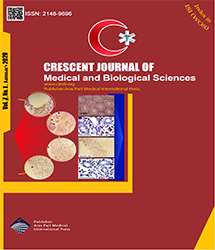
| Original Article | |
| The Study of Silicon Shoes Insert Benefts in Symptom and Radiology of Patients With Idiopathic Femoral Head Osteonecrosis: Two Arms Randomized Controlled Trial | |
| Alireza Sadeghpour1, Hossein Aslani1, Morteza Gojazadeh1, Mahdi Pashazadeh1 | |
| 1Department of Orthopedics, Shohada Hospital, Medical Faculty of Tabriz University, Tabriz, Iran | |
|
CJMB 2020; 7: 104–109 Viewed : 4204 times Downloaded : 18313 times. Keywords : ION of the femoral head, HHS, Ficat, Shoe insert, Osteoarthritis |
|
| Full Text(PDF) | Related Articles | |
| Abstract | |
Objectives:C Femoral head osteonecrosis in one of the most common orthopedic diseases in which the exact etiology is unknown and has no specifc treatment. This study was designed and with the theory of stopping the disease or at least showing down the progression of the disease and reducing the pain of patients with femoral head idiopathic osteonecrosis (ION). Materials and Methods: This study was designed as a randomized clinical trial in which two control and interventional groups with a shoe insert were compared over a period of one year. The shoe insert was made of silicone gel and leather carbide with a thickness of one cm on the heel which gradually reduced until paw and was used at both feet. The study was considered to be meaningful with P<0.05. Results: A total of seven out of 14 patients were included in every group. They were followed up on a 4-time basis every 3 months and for 1 year. Harris Hip Score (HHS) and Ficat forms were completed for everyone. Despite the clinical satisfaction of the patients regarding the use of the shoe insert, HHS was not meaningful in their viewpoints. The progression of the disease was based on the Ficat form and according to P<0.003 although it was mildly meaningful and showed down the progression of femoral head ION in patients who used a shoe insert in the intervention group. Conclusions:Although shoes insert clinically controlled pain in patients, it was not signifcant in data analysis. Finally, the use of shoe inserts could help slow down the progression of the ION femoral head. |
Cite By, Google Scholar
Google Scholar
PubMed
Online Submission System
 CJMB ENDNOTE ® Style
CJMB ENDNOTE ® Style
 Tutorials
Tutorials
 Publication Charge
Medical and Biological Research Center
About Journal
Publication Charge
Medical and Biological Research Center
About Journal
Aras Part Medical International Press Editor-in-Chief
Arash Khaki
Deputy Editor
Zafer Akan


















